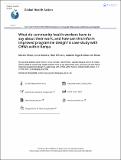| dc.identifier.citation | Martin Oliver, Anne Geniets, Niall Winters, Isabella Rega & Simon M. Mbae (2015) What do community health workers have to say about their work, and how can this inform improved programme design? A case study with CHWs within Kenya, Global Health Action, 8:1, DOI: 10.3402/gha.v8.27168 | en_US |
| dc.description | Global Health Action 2015. # 2015 Martin Oliver et al. This is an Open Access article distributed under the terms of the Creative Commons Attribution 4.0
International License (http://creativecommons.org/licenses/by/4.0/), allowing third parties to copy and redistribute the material in any medium or format and to
remix, transform, and build upon the material for any purpose, even commercially, provided the original work is properly cited and states its license | en_US |
| dc.description.abstract | Background: Community health workers (CHWs) are used increasingly in the world to address shortages of
health workers and the lack of a pervasive national health system. However, while their role is often described
at a policy level, it is not clear how these ideals are instantiated in practice, how best to support this work, or
how the work is interpreted by local actors. CHWs are often spoken about or spoken for, but there is little
evidence of CHWs’ own characterisation of their practice, which raises questions for global health advocates
regarding power and participation in CHW programmes. This paper addresses this issue.
Design: A case study approach was undertaken in a series of four steps. Firstly, groups of CHWs from two
communities met and reported what their daily work consisted of. Secondly, individual CHWs were interviewed so that they could provide fuller, more detailed accounts of their work and experiences; in addition,
community health extension workers and community health committee members were interviewed, to provide
alternative perspectives. Thirdly, notes and observations were taken in community meetings and monthly
meetings. The data were then analysed thematically, creating an account of how CHWs describe their own
work, and the tensions and challenges that they face.
Results: The thematic analysis of the interview data explored the structure of CHW’s work, in terms of the
frequency and range of visits, activities undertaken during visits (monitoring, referral, etc.) and the wider
context of their work (links to the community and health service, limited training, coordination and mutual
support through action and discussion days, etc.), and provided an opportunity for CHWs to explain their
motivations, concerns and how they understood their role. The importance of these findings as a contribution
to the field is evidenced by the depth and detail of their descriptive power. One important aspect of this is
that CHWs’ accounts of both successes and challenges involved material elements: leaky tins and dishracks
evidenced successful health interventions, whilst bicycles, empty first aid kits and recruiting stretcher bearers
evidenced the difficulties of resourcing and geography they are required to overcome.
Conclusion: The way that these CHWs described their work was as healthcare generalists, working to serve their
community and to integrate it with the official health system. Their work involves referrals, monitoring,
reporting and educational interactions. Whilst they face problems with resources and training, their accounts
show that they respond to this in creative ways, working within established systems of community power and
formal authority to achieve their goals, rather than falling into a ‘deficit’ position that requires remedial
external intervention. Their work is widely appreciated, although some households do resist their interventions,
and figures of authority sometimes question their manner and expertise. The material challenges that they face
have both practical and community aspects, since coping with scarcity brings community members together.
The implication of this is that programmes co-designed with CHWs will be easier to implement because of their
relevance to their practices and experiences, whereas those that assume a deficit model or seek to use CHWs as
an instrument to implement external priorities are likely to disrupt their work. | en_US |

